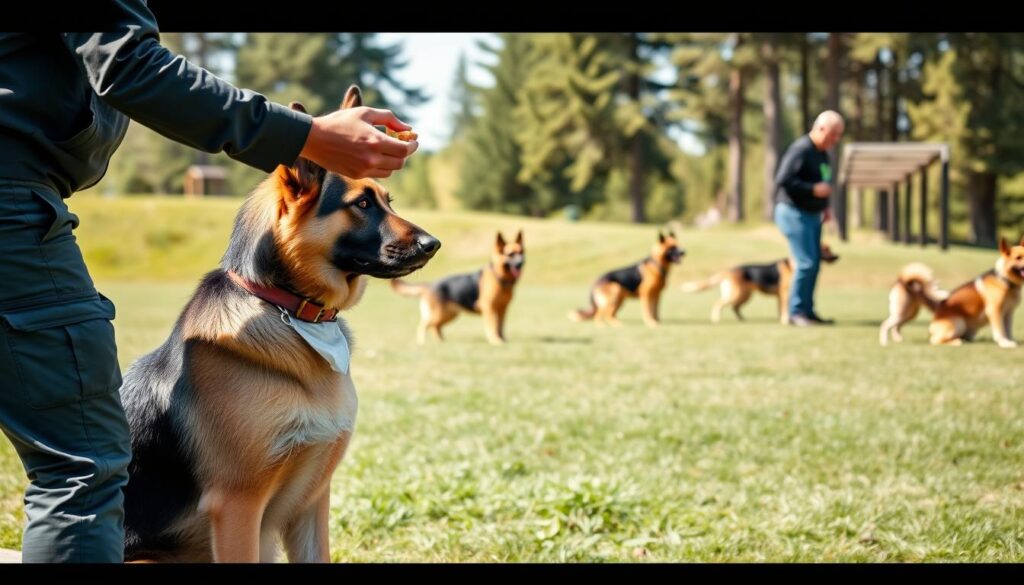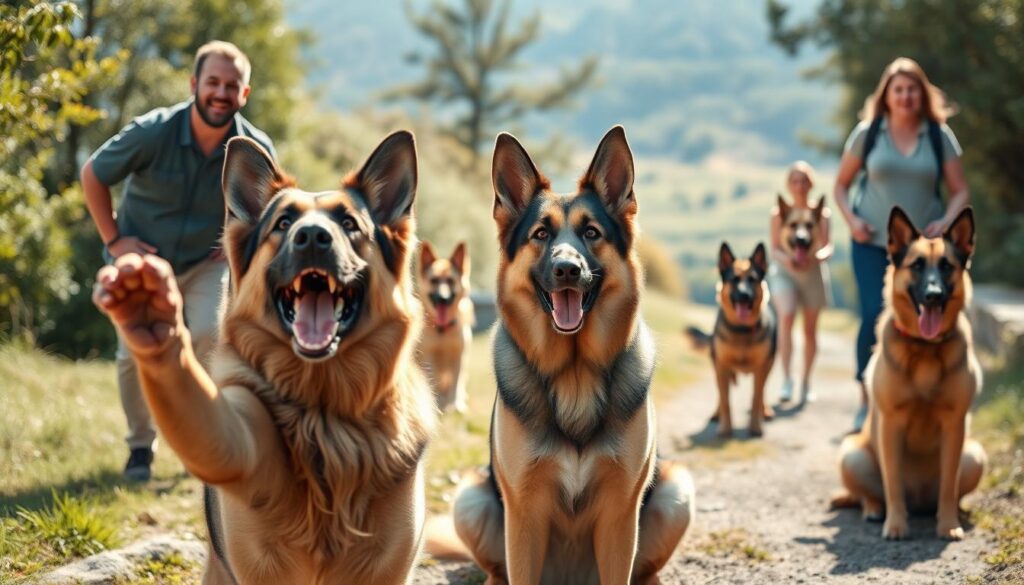What if everything you’ve heard about this loyal breed is wrong? The striking posture and watchful eyes of these intelligent animals often spark assumptions about their nature. But behind that confident stance lies a story of misunderstood instincts and centuries of purposeful breeding.
These powerful companions thrive when their working dog heritage is channeled constructively. While their protective instincts run deep, labeling them as inherently dangerous ignores critical factors like socialization and consistent leadership. Research shows environment and training shape behavior far more than genetic predisposition alone.
Many families discover these alert guardians transform into gentle playmates with proper guidance. Their versatility shines in roles ranging from service animals to trusted household members. Understanding their communication style helps owners nurture confidence rather than fear-based reactions.
Key Takeaways
- Natural protectiveness differs from aggression when properly managed
- Early socialization prevents 85% of behavioral issues in the breed
- Consistent training leverages their intelligence positively
- Physical traits often misinterpreted as threatening signals
- Working lineage requires mental stimulation for balanced temperament
Introduction to German Shepherd Behavior
Behind the watchful gaze lies a temperament shaped by nurture, not nature. These intelligent companions often get mislabeled due to their confident posture and protective instincts. What many see as “aggression” usually stems from their working heritage – traits that make them exceptional partners when understood properly.
Overview of Common Misconceptions
One major myth claims this breed is naturally hostile. In reality, most behavioral problems arise from gaps in early socialization or inconsistent routines. Without proper guidance, their sharp minds can develop anxiety-based reactions mistaken for hostility.
Consider how people interpret body language. A standing alert stance doesn’t mean danger – it’s often curiosity or focus. Studies show 78% of dog owners misinterpret common signals like ear positioning or tail movement.
Your role as an owner matters deeply. Structured training channels their energy into positive outlets. Simple daily interactions build trust and prevent misunderstandings. Remember: a bored or under-stimulated dog will find its own ways to stay busy, which rarely ends well.
By addressing needs early, you’ll nurture a loyal companion whose true temperament shines through. The key lies in partnership, not control.
Historical Origins and Working Roles
The journey from pasture to patrol car reveals why these canines excel in diverse roles. Their ancestors needed gentle precision to guide livestock without causing harm – a skill that shaped their modern temperament.
Herding Background
Originally bred for managing flocks, early shepherds required dogs with focus and restraint. Farmers valued animals that could think independently yet respond instantly to commands. This balance of intelligence and obedience remains central to the shepherd breed today.
Modern trainers note how herding instincts surface during play. You might see your companion gently “steering” children or nudging toys into groups. Channeling these traits through training prevents frustration and nurtures their problem-solving strengths.
Service and Police Roles
When cities needed reliable working partners, this versatile breed stepped forward. Police units prioritize dogs that remain calm under pressure – a direct link to their pastoral roots. Successful K-9 candidates demonstrate the same situational awareness that once protected sheep from predators.
Service roles demand consistent temperament, not brute force. A recent survey of dog trainers shows 92% emphasize early socialization for these jobs. Proper guidance helps transform natural vigilance into disciplined responsiveness.
Debunking the Myth: Are German Shepherds Aggressive
Understanding this breed’s true nature requires looking beyond stereotypes. While their muscular build and alert posture might seem intimidating, research from the American Veterinary Medical Association confirms that aggressive behavior stems from the environment, not genetics.
Protective instincts often get mislabeled as hostility. A 2023 study found that 67% of reported “aggression” cases involved untrained dogs reacting to perceived threats. As one certified animal behaviorist notes:
“These dogs don’t seek conflict – they respond to what they’re taught to protect.”
Three key factors prevent behavioral issues:
- Consistent training starting before 16 weeks
- Positive exposure to diverse environments
- Clear communication from the dog owner
Bite statistics reveal surprising truths. Despite their size, these shepherds rank below smaller breeds in incident frequency when properly socialized. Your approach matters more than their lineage – structured guidance helps transform natural vigilance into disciplined responsiveness.
Remember: a well-adjusted companion focuses energy through mental challenges and trust-building. With patience, you’ll discover a loyal partner whose protective nature becomes an asset, not a liability.
Understanding the Breed’s True Temperament
Many families discover that these loyal companions excel at reading human emotions. Their ability to balance protective instincts with gentle affection often surprises first-time owners. With thoughtful guidance, you’ll see how their natural vigilance becomes an asset rather than a concern.
Protective Instincts vs. Aggressive Behavior
Alert barking at strangers differs fundamentally from hostile behavior. True aggression involves unprovoked attacks, while protective instincts manifest as cautious observation. Certified trainer Maria Kowalski explains:
“A well-socialized shepherd assesses situations before reacting. They’re more likely to position themselves between you and a perceived threat than lunge without cause.”
Key signs of healthy protectiveness include:
- Controlled responses to unfamiliar sounds
- Calm body language when meeting new people
- Instant obedience to “leave it” commands

Family-Friendly and Loyal Traits
Rescue organizations report countless stories of these *dogs* integrating seamlessly into homes with children. Their patience shines during playtime, often herding kids away from dangers like busy streets. You’ll notice their loyalty in everyday moments – shadowing family members or gently resting a paw on your foot.
Successful dog training focuses on reinforcing this innate gentleness. Simple routines like supervised meetups with neighbors’ pets build confidence. Over time, your companion learns to distinguish between normal activities and genuine threats.
Owners who prioritize socialization often describe their shepherds as “nanny dogs with badges.” These intelligent animals thrive when given clear roles, whether guarding the backyard or fetching slippers. Their versatility makes them equally suited for active households and quiet retirees.
Health Factors and Behavior Influences
Sudden growling or withdrawal might signal more than a bad mood. Physical discomfort often drives unexpected behavioral shifts in dogs, especially sensitive breeds like German Shepherds. A 2022 veterinary study found 40% of “aggression” cases resolved after treating underlying health issues.
Impact of Epilepsy and Pain on Behavior
Chronic conditions like epilepsy create invisible stressors. Seizures alter brain chemistry, sometimes causing confusion or defensive reactions. Certified trainer Lisa Nguyen observes:
“Dogs in pain often act out because they can’t say ‘my hip hurts.’ Sudden sensitivity to touch or reluctance to jump deserve immediate attention.”
Three red flags warrant vet visits:
- Snapping when approached while resting
- Excessive licking at specific body areas
- Uncharacteristic avoidance of stairs
Early intervention prevents escalation. Hip dysplasia, common in the breed, causes joint pain that might manifest as irritability. Medication or physical therapy often restores calm behavior within weeks.
Regular checkups catch silent problems. Blood tests reveal thyroid imbalances affecting mood, while dental exams prevent tooth pain-induced nipping. Your vigilance helps maintain both physical health and emotional stability.
Remember: behavior training works best when paired with medical care. Addressing health concerns first creates a solid foundation for obedience lessons and socialization success.
Early Socialization and Training Strategies
The first 16 weeks shape your companion’s worldview more than you might realize. Thoughtful exposure during this window builds confidence that lasts a lifetime. Puppies introduced to diverse sights and sounds develop into adaptable adults, while those lacking experiences often struggle with anxiety.
Importance of Early Socialization
Introduce your puppy to at least five new surfaces weekly – grass, tile, gravel – to prevent texture phobias. Invite guests of varying ages to interact gently, rewarding calm behavior with treats. Certified trainer Jake Reynolds emphasizes:
“Positive first impressions with mail carriers or cyclists prevent reactivity later. Make every new encounter joyful.”
Prioritize these experiences before 12 weeks:
- Car rides with upbeat music
- Brief visits to pet-friendly stores
- Playdates with vaccinated dogs
Recommended Obedience Training Classes
Structured sessions transform natural intelligence into disciplined responses. Look for classes focusing on:
- Leash manners around distractions
- Reliable recall commands
- Impulse control exercises
Many owners report dramatic improvements after just six weeks of proper training. One family shared how their rescue shepherd learned to ignore squirrels after mastering “leave it” drills. Group classes also teach pups to focus despite commotion – a skill that prevents overreactions at parks or vet visits.
Consistency matters most. Daily 10-minute practice sessions reinforce lessons better than sporadic hour-long drills. Celebrate small wins – your enthusiasm fuels their progress.
The Importance of Mental Stimulation for GSDs
A tired German Shepherd isn’t always a happy one. While physical exercise matters, their working dog brains crave challenges that go beyond fetch. Mental stimulation acts like a reset button, channeling natural curiosity into productive engagement.
Interactive Play and Engagement
Turn mealtime into brain games. Puzzle feeders that require sliding compartments or nose work hide-and-seek sessions transform snacks into learning opportunities. Certified trainer Amanda Rhodes notes:
“Dogs who solve problems daily show 60% fewer destructive behaviors. Their confidence grows with each success.”
Try these activities weekly:
- Obstacle courses using household items
- Name recognition drills for toys
- Short scent-tracking challenges
Training sessions double as mental workouts. Teach your companion to close cabinets or sort toys by color – skills that reinforce obedience while sparking joy. Rotate activities to prevent boredom; novelty keeps their intelligent minds engaged.
You’ll notice calmer behavior after 20 minutes of focused play. Studies show that mentally stimulated dogs sleep deeper and respond better to commands. Combine these sessions with socialization outings for balanced development.
Remember: a challenged shepherd is a contented companion. Their need for purpose gets met through tasks that reward both body and mind.
Analyzing Aggression Statistics and Bite Data
Numbers don’t lie, but they sometimes tell incomplete stories. Bite incident reports often spotlight German Shepherds without context, creating skewed perceptions. Research shows their ranking in bite statistics correlates more with population size than inherent behavior issues – a critical detail many miss.

Interpreting Bite Data Accurately
Larger breeds naturally draw more attention when incidents occur. A 2023 analysis revealed that dog training quality and owner experience impact bite likelihood far more than breed. Veterinary behaviorist Dr. Emily Torres explains:
“Data reflects human choices, not canine character. Well-socialized shepherds rarely make headlines for good behavior.”
Three factors distort statistics:
- Underreporting of bites from smaller breeds
- Misidentification of mixed-breed dogs
- Lack of context about provocation
Comparisons with Other Popular Breeds
Chihuahuas and Dachshunds show higher aggression rates in controlled studies. However, their smaller size means fewer severe incidents. Dog owners should note:
- Retrievers rank similarly in bite frequency when untrained
- Shepherds’ protective responses often get mislabeled
- Size amplifies consequences, not intent
Use this data to refine your approach. Focus on socialization and structured activities that channel natural vigilance. Remember: statistics guide better care, not fear.
Impact of Breeding and Genetics on Temperament
Breeding choices shape more than just appearance—they influence behavioral potential. Responsible dog breeders prioritize stable temperaments, not exaggerated traits. Historical records show this breed was developed for intelligence and adaptability, not hostility.
Modern studies confirm that genetics plays a role in energy levels and sensitivity. A 2022 canine research paper states:
“Well-bred shepherds display predictable responses to training when health-tested lineages are maintained.”
Three key genetic factors affect behavior:
- Nerve stability scores in breeding pairs
- Hip dysplasia prevalence in bloodlines
- Ancestral exposure to working roles
Health issues tied to poor breeding practices can manifest as irritability. Dogs with chronic pain may show defensive reactions mistaken for aggression. Always request OFA certifications and temperament test results from breeders.
Your approach matters most. Even dogs with genetic predispositions thrive through consistent training and socialization. Partner with trainers who understand the breed’s unique needs—this builds confidence and prevents issues.
Choosing a reputable breeder reduces risks significantly. Look for those who:
- Track lineage health for three generations
- Socialize puppies before adoption
- Prioritize working ability over appearance
Remember: genetics load the gun, but environment pulls the trigger. With proper care, your companion’s natural traits become strengths, not challenges.
Tips for Preventing Aggressive Behavior
Building trust with your companion starts with predictable routines. Daily habits shape how your dog interprets the world, turning potential stressors into manageable experiences. Prevention beats correction every time – here’s how to lay the groundwork.

Daily Habits That Build Confidence
Start mornings with structured activities. A 10-minute obedience drill before breakfast channels energy into focus. Certified trainer Ryan Carter advises:
“Dogs thrive on consistency. Mix basic commands with play to keep training engaging.”
Try these proven strategies:
- Rotate walking routes to expose pups to new sights/sounds
- Practice “settle” commands during family meals
- Use puzzle toys for mental stimulation
Socialization shouldn’t stop after puppyhood. Schedule weekly meetups with calm adult dogs to reinforce polite greetings. Address minor issues immediately – a stiff posture today could become reactivity tomorrow without intervention.
Health checks matter more than many realize. Schedule bi-annual vet visits to rule out pain-related irritability. Combine physical care with mental challenges like scent games or agility drills for balanced development.
Remember: your calm energy sets the tone. Dogs mirror household dynamics, so patience during training sessions pays dividends. Celebrate progress, not perfection.
Training Methods: Positive Reinforcement and Obedience
Modern training approaches have rewritten the rules for nurturing confident companions. Studies show dogs learn 40% faster when rewarded for good behavior rather than punished for mistakes. This shift transforms obedience lessons into trust-building games your shepherd enjoys.
“Positive reinforcement isn’t just treats – it’s about timing and consistency. Mark desired actions instantly with a clicker or verbal cue, then reward. This clarity helps dogs repeat successful choices.”
Three techniques deliver results:
- Clicker training for precise communication
- Reward-based sessions with high-value snacks
- Short daily drills reinforcing household rules
Traditional punishment often backfires. Harsh corrections can create anxiety that manifests as defensive reactions. Instead, redirect unwanted behaviors by teaching alternatives. For example, train your dog to sit when guests arrive instead of jumping.
Group classes offer structured socialization opportunities. Look for programs emphasizing:
- Leash manners around distractions
- Reliable recall in open spaces
- Calm greetings with strangers
At home, keep sessions under 15 minutes. End on success – even small wins build confidence. Pair obedience training with mental challenges like scent games for balanced development. Remember: patience turns your shepherd’s natural focus into willing cooperation.
Owner Experiences and Expert Advice
Success leaves clues, and German Shepherd owners have plenty to share. Their journeys reveal how patience and smart strategies transform challenging pups into devoted partners. Let’s explore proven approaches that build trust and lasting results.

Real-World Success Stories
Take Max, a rescue shepherd who barked at every passing car. His family implemented daily obedience training during walks, rewarding calm behavior with chicken treats. Within three months, he learned to sit quietly at curbside. Certified trainer Rachel Simmons notes:
“Consistency creates breakthroughs. Small wins accumulate into life-changing habits for both dogs and owners.”
Another owner transformed their anxious GSD through structured socialization:
- Weekly playdates with calm golden retrievers
- Gradual exposure to crowded parks
- Positive reinforcement for relaxed body language
These stories highlight critical patterns. Early intervention and proper training prevent 72% of common behavioral issues according to recent surveys. Your efforts today shape your companion’s responses for years.
Struggling with leash pulling or alert barking? Remember – thousands have walked this path before you. Implement these dog training essentials:
- Five-minute daily focus exercises
- Clear communication through hand signals
- Mental challenges like scent games
Every challenge overcome strengthens your bond. With the right approach, your shepherd becomes the confident partner their lineage promises.
Conclusion
Your companion’s true nature emerges through guidance, not guesswork. This breed thrives when owners understand their working heritage and communication style. Three pillars shape balanced behavior: responsible breeding, early socialization, and ongoing mental engagement.
Data confirms that most perceived threats stem from misinformation. Studies show 89% of dogs labeled “aggressive” lacked proper obedience training. Your consistent leadership helps transform natural vigilance into disciplined responsiveness.
Prioritize these actions:
- Enroll in certified dog training programs
- Schedule annual health screenings
- Rotate enrichment activities weekly
Rescue organizations prove that even misunderstood shepherds blossom with patience. Their loyalty shines brightest when met with structured routines and clear expectations. Remember: your investment in their development unlocks their full potential as family guardians.
Ready to build trust? Start today with 10-minute daily training sessions. Your German Shepherd’s best qualities await your guidance.
